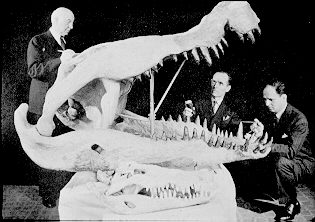| Crocodiles

Dinosuchus
Deinosuchus ("terrible crocodile")
is an extinct crocodile from the late Cretaceous
of North America that for decades was known as
the largest crocodile that ever lived. Deinosuchus
is known primarily from skull material, and recent
studies have reduced its projected length. A number
of other giant crocodiles, including Sarcosuchus
(the "SuperCroc"), Purussaurus and Rhamphosuchus,
may now exceed it in size, though comparison is
difficult because only the SuperCroc is known
from a largely-complete skeleton.

The skull of Deinosuchus measures
more than 2 m (6 ft 7 in) from front to back and
has a broad rather than narrow snout. Recent studies
have reduced the estimate of the animal's total
length from more than 15 m (50 ft) to between
10 and 12 m (33 & 40 ft). Even at this reduced
estimate, Deinosuchus is much larger than the
saltwater crocodile, of Australia, and Southern
and Southeast Asia, which is the biggest living
reptile.
The proportions of Deinouchus are
similar to the skull of today's Nile crocodile,
which specializes in hunting fish but also readily
preys on large animals like the antelope and zebra.
Deinosuchus probably lurked in rivers or swamps,
waiting for prey to come and drink from the water's
edge. It would grab the victim in its massive
jaws, studded with long but not especially sharp
teeth, and then drag it into the water to drown,
or perhaps spin around lengthwise like a top,
to tear of chunks of flesh (the "death roll").
Its prey probably included dinosaurs, large fish,
and swimming reptiles.
Deinosuchus has been discovered in both freshwater
and marine deposits.
The type species, Deinosuchus hatcheri was discovered
by Holland at Willow Creek, Montana, in the Judith
River Formation. Material from Big Bend National
Park in Texas was originally assigned to the Phobosuchus
genus in 1954 by Colbert and Bird, but is now
assigned to a Deinosuchus species, D. riograndensis.
Specimens have also been found in Alabama, Georgia,
New Jersey, North Carolina, and Wyoming.
Originally classified in the Crocodylidae family,
a better skull specimen indicates it is most likely
a basal alligator in the superfamily Alligatoroidea.
Crocodiles (Crocs)
A crocodile is any species belonging to the family
Crocodylidae (sometimes classified instead as
the subfamily Crocodylinae). The term can also
be used more loosely to include all members of
the order Crocodilia: i.e. the true crocodiles,
the alligators and caimans (family Alligatoridae)
and the gharial (family Gavialidae).
The crocodiles (colloquially called crocs), are
large aquatic reptiles that live throughout the
Tropics in Africa, Asia, the Americas and Australia.
Crocodiles tend to congregate in slow-moving rivers
and lakes, and feed on a wide variety of living
and dead mammals and fish. Some species, notably
the Saltwater Crocodile of Australia and the Pacific
islands, have been known to venture far out to
sea. They are an ancient lineage, and are believed
to have changed little since the time of the dinosaurs.
The larger species of crocodiles can be very
dangerous to humans. The Saltwater and Nile Crocodiles
are the most dangerous, killing hundreds of people
each year in parts of South-East Asia and Africa.
American Alligators, and possibly the endangered
Black Caiman, are also dangerous to humans.
Crocodiles are very fast over short distances,
even out of water. They have extremely powerful
jaws and sharp teeth for tearing flesh, but cannot
open their mouth if it is held closed, hence there
are stories of people escaping from the long-snouted
Nile Crocodile by holding its jaws shut. Indeed,
zoologists will often subdue crocodiles for study
or transport by taping their jaws or holding their
jaws shut with large rubber bands cut from automobile
inner tubes. All large crocodiles also have sharp
welters and powerful claws. They have limited
lateral movement in their neck, so on land one
can find protection by getting even a small tree
between the crocodile's jaws and oneself.
Crocodiles are ambush hunters, waiting for fish
or land animals to come close, then rushing out
to attack. As cold-blooded predators, they can
survive long periods without food, and rarely
need to actively go hunting. Despite their slow
appearance, crocodiles are the top predators in
their environment, and various species have been
observed attacking and killing lions, large ungulates
and even sharks. A famous exception is the Egyptian
Plover which enjoys a symbiotic relationship with
the crocodile. The Plover feeds on parasites that
infest the crocodile's mouth and the reptile will
open its jaws and allow the bird to enter to clean
out the mouth. The crocodile's bite strength is
up to 3000 pounds per square inch, comparing to
just 100 psi for a large dog.
The largest species of crocodile, also Earth's
largest reptile, is the Saltwater Crocodile, found
in northern Australia and throughout South-east
Asia.
Crocodiles eat fish, birds, mammals and occasionally
smaller crocodiles.
Wild crocodiles are protected in many parts of
the world, but they also are farmed commercially.
Their hide is tanned and used to make leather
goods such as shoes and handbags, whilst crocodile
meat is also considered a delicacy in many parts
of the world. The most commonly farmed species
are the Saltwater and Nile crocodiles, while a
hybrid of the Saltwater and the rare Siamese Crocodile
is also bred in Asian farms. Farming has resulted
in an increase in the Saltwater Crocodile population
in Australia, as eggs are usually harvested from
the wild, so landowners have an incentive to conserve
crocodile habitat. Crocodiles are more closely
related to birds and dinosaurs than to most animals
classified as reptiles (though all of these are
thought to probably be more closely related to
each other than to Testudines (turtles and tortoises),
and have correspondingly unusual features for
reptiles, such as a four-chambered heart.
source: wikipedia.org |